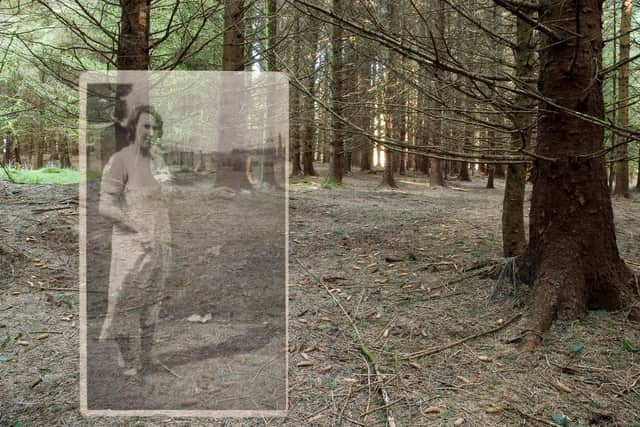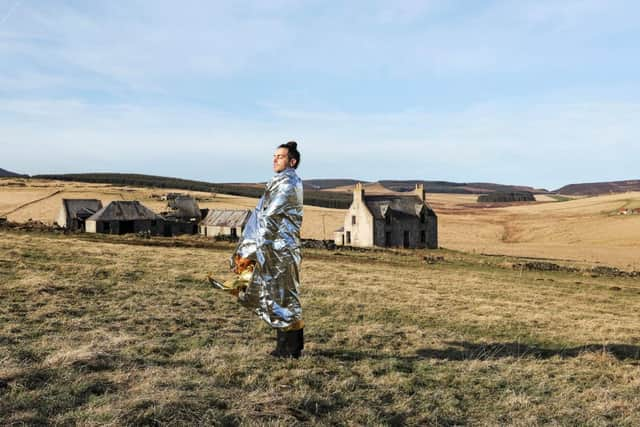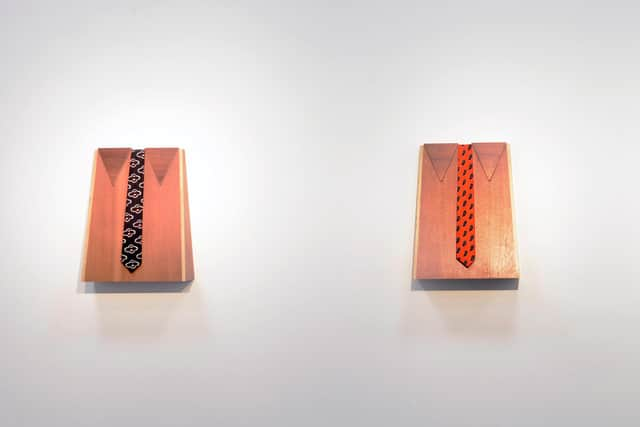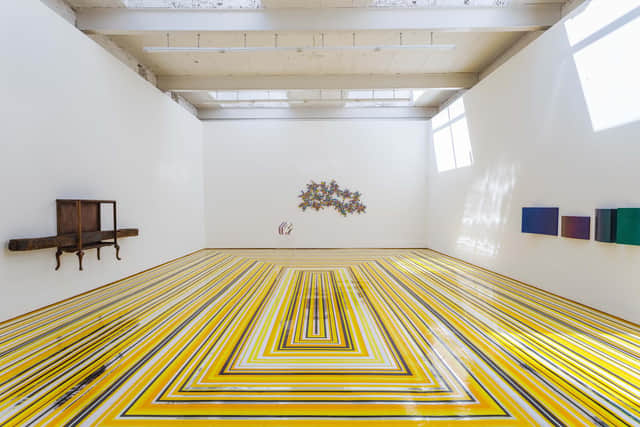Art reviews: Nicky Bird | Iman Tajik | Ambi | Jim Lambie


Nicky Bird: Legacy, Street Level Photoworks, Glasgow ****
Projects 20: Iman Tajik, Stills, Edinburgh ***
Ambi, CCA, Glasgow ***


Jim Lambie: Buttercup, Modern Institute, Glasgow ****
A photograph can become history very quickly. This comes across forcefully in the family snaps used by artist and photographer Nicky Bird. A family picnics in front of a block of flats; in a few short years, the children are grown and the flats demolished. The speed of change is particularly true in the kinds of places which interest Bird most – ordinary communities which change with the fickle fortunes of local industries.
Her show at Street Level Photoworks, bringing together work from the last 15 years, begins with Beneath the Surface/Hidden Place, superimposing family or childhood photographs from collaborators on to images of how the same places look now. The photographs bleed into one another, merging past and present, person and place.
Advertisement
Hide AdIn Travelling the Archive she took an archive of slides by Joan Wilcock, a regular visitor to Skye on holiday who took snapshots of locals, particularly children. Bird worked with a Kyleakin heritage group to put names to the faces, then projected the slides on to local buildings.


Sometimes, her focus is a building, such as Helmsdale Castle, demolished in the 1970s to make way for the A9 bridge and living on in old postcards and holiday snaps, or Westwood in West Calder, the grand house the remnants of which now lie under slag heaps. Or Nivens Knowe Miners Welfare Club in Midlothian, opened in a flurry of modernist confidence in 1958 and in use for less than a decade.
But at the heart of the work are the people: the holiday-maker snapped by the ruined castle; the beauty contest at the Miners Welfare Club; the women decorators who worked at Portobello’s Buchan & Co pottery, brought to life again in a vibrant snapshot from the 1960s. Because the work lies in the connections to people as much as the images, it would be helpful to have more information about the projects. The more there is, the more the show becomes an invitation down the rabbit hole of other people’s pasts, and by extension, a reflection on our own.
The stories of displaced people, past and present, are linked in the work of Iran-born artist and photographer Iman Tajik in his solo show at Stills, which is part of the gallery’s Projects 20 initiative for emerging artists. The Dreamers is a series of performance-based photographs made during his residency last year at Deveron Projects in Huntly.
The artist is pictured on the high moorlands of Aberdeenshire, depopulated by Clearances and (in some cases) still the subject of land disputes today. He has a flag made from a gold foil emergency blanket; we see him tied to it, wrapped in it. While these images are somewhat repetitive, his presence becomes the bridge which links the history of those empty cottages and farms to today’s international refugee situation, and wider questions of nationhood and nationality.


A second body of work was made in 2015 on a visit to the refugee camp known as The Jungle in Calais, home to over 6,000 people before it was demolished. There are elements of documentary photography here: makeshift shelters, a mirror tied to a tree, portraits with faces partially obscured. But Tajik is always looking for new ways to convey the bigger picture: a time-lapse film which loops from day to night to day again, a sequence of interminable days; the light-saturated folds of a tent seen from the inside; the smoke trails of a plane, which becomes a metaphor for so much more.
Advertisement
Hide AdIn Ambi, originally planned for last year, and now granted the briefest of runs at CCA, four artists were invited to respond to the textiles, fashion and costume holdings at Glasgow School of Art’s archives and collections. In this rich trove of materials, each finds a thread which appeals to them and follows it in a direction of their choosing.
Rabiya Choudhry engages head-on with the Paisley motif, which began life in the Middle East and became popular in both India and Europe (“ambi” is the Punjabi word for it). She boldly drags the iconic teardrop shape into the 21st century with her own printed fabrics, working in bright primary colours and splicing in the contemporary language of cartoons and emojis.
Advertisement
Hide AdHanneline Visnes is drawn to the costume designs of Dorothy Carleton Smyth, a former teacher at GSA who was appointed director in 1933 but died of a brain haemorrhage before she could take up the post. A series of Smyth’s stylish designs, for Macbeth and Wilde’s Salome, is included in the show. Visnes’ impressive painted frieze, Force, a combination of figurative painting and patterns, is nominally in conversation with them, but the connections are tangential. Really, it stands alone, a meditation on the generations of students and teachers who have studied older designs and made new ones, the ongoing flow of art school life through time.


Raisa Kabir’s sculpture and film engages with the colonial geography of labour but, while thoughtfully atmospheric, it doesn’t do much to open up a complex and thorny issue. Fiona Jardine’s work is an hour-long lecture probing the densely woven history of Donegal carpets. The four artists have gone in such different directions, and work in such different styles, that the results coexist in the same show but don’t form a basis for dialogue.
For a contemporary legacy of pattern and colour in Glasgow, one needs look no further than Jim Lambie’s famous floors created using coloured vinyl tape. The first Zobop was shown at Transmission Gallery 22 years ago and has gone around the world in different iterations and colours. Now, a new version is back, just a stone’s throw from where it began, at the Modern Institute, as part of a rare Lambie show.
So captivating is it that the rest of the work is in danger of being upstaged by the floor. Wildflower, in black, white, silver and shades of yellow, lights up the space on a grey Glasgow day until it buzzes like a swarm of psychedelic bumble bees. But it’s worth spending time with the other work too. Lambie is adept at working with colour, and transforming everyday objects into something much more interesting: lenses from coloured sunglasses are joined together with lead like medieval stained glass; jigsaw puzzle pieces create an undulating surface of dark metallic tones.
He brings together graffiti and urban references with hints of the pastoral (buttercups, goldfinches) and presents a quirky video self-portrait in which he dissolves his own face in spray paint creating sequences of monochrome colours. Most interesting of all, perhaps, is how he plays with weight: a display cabinet punctured by a railway sleeper, both seemingly weightless, and a sculpture which seems to float on a transparent plinth. Lambie is usually playful, and often fun, but this show reminds us how well he grasps the serious considerations of sculpture as well.
Nicky Bird:Legacy is at Street Level until 6 June, then online at https://my.matterport.com/show/?m=MPvnXeYqsok; Iman Tajik is at Stills until 19 June; Ambi is at the CCA until 29 May; Jim Lambie, run ended, but online at https://www.themoderninstitute.com/viewing-room/jim-lambie
A message from the Editor:
Advertisement
Hide AdThank you for reading this article. We're more reliant on your support than ever as the shift in consumer habits brought about by coronavirus impacts our advertisers.
If you haven't already, please consider supporting our trusted, fact-checked journalism by taking out a digital subscription at https://www.scotsman.com/subscriptions